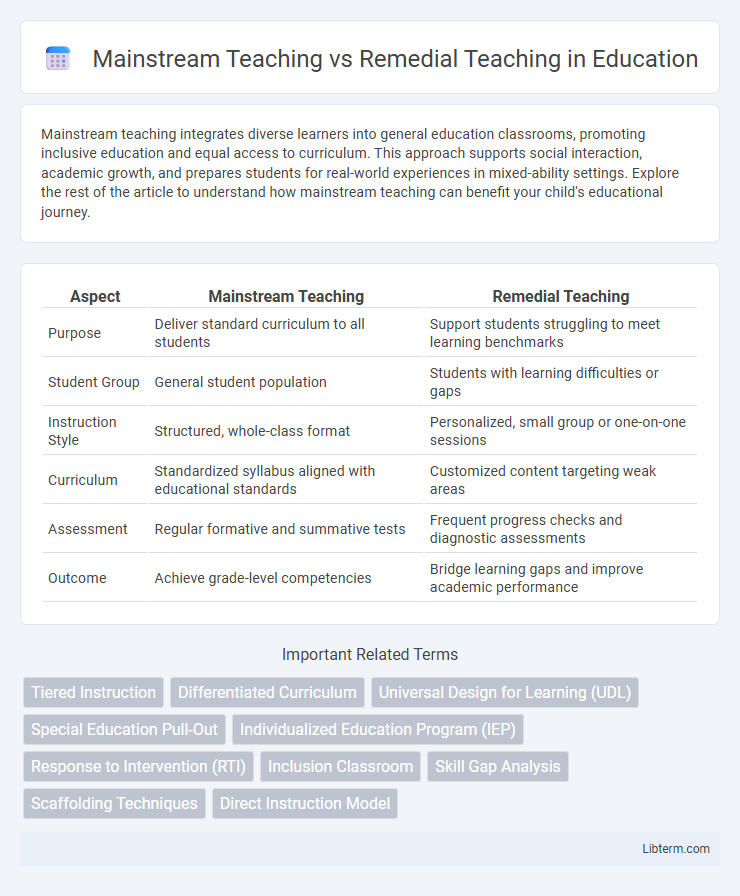Mainstream teaching integrates diverse learners into general education classrooms, promoting inclusive education and equal access to curriculum. This approach supports social interaction, academic growth, and prepares students for real-world experiences in mixed-ability settings. Explore the rest of the article to understand how mainstream teaching can benefit your child's educational journey.
Table of Comparison
| Aspect | Mainstream Teaching | Remedial Teaching |
|---|---|---|
| Purpose | Deliver standard curriculum to all students | Support students struggling to meet learning benchmarks |
| Student Group | General student population | Students with learning difficulties or gaps |
| Instruction Style | Structured, whole-class format | Personalized, small group or one-on-one sessions |
| Curriculum | Standardized syllabus aligned with educational standards | Customized content targeting weak areas |
| Assessment | Regular formative and summative tests | Frequent progress checks and diagnostic assessments |
| Outcome | Achieve grade-level competencies | Bridge learning gaps and improve academic performance |
Introduction to Mainstream and Remedial Teaching
Mainstream teaching involves educating students within a general classroom setting alongside their peers, promoting inclusivity and standard curriculum delivery. Remedial teaching targets students who require additional support to meet academic standards, offering personalized instruction to address learning gaps. Both approaches aim to optimize student learning outcomes by tailoring education to diverse learner needs.
Key Differences Between Mainstream and Remedial Teaching
Mainstream teaching follows a standardized curriculum designed for the general student population, emphasizing overall academic progression and inclusion in typical classroom settings. Remedial teaching targets students who struggle with core subjects, providing customized instruction to address specific learning gaps and improve foundational skills. Key differences include instructional pace, curriculum adaptation, and tailored support intensity to meet diverse learner needs effectively.
Objectives of Mainstream Teaching
Mainstream teaching aims to deliver a comprehensive curriculum designed to meet the educational needs of the majority of students, promoting overall academic development and social integration. It focuses on fostering critical thinking, collaboration, and grade-level competency across core subjects such as mathematics, language arts, and science. The goal is to create an inclusive learning environment that supports diverse learners while maintaining high academic standards.
Goals of Remedial Teaching
Remedial teaching aims to identify and address specific learning gaps to help students achieve grade-level proficiency and improve academic performance. It focuses on personalized instruction targeting foundational skills in areas such as reading, writing, and mathematics to build confidence and competence. The goal is to equip learners with essential knowledge and strategies for successful integration into mainstream education.
Student Profiles in Mainstream Classrooms
Mainstream classrooms typically accommodate a diverse range of student profiles, including those with average academic abilities, varying learning paces, and different socio-emotional needs. Students in mainstream settings often benefit from exposure to a standard curriculum designed to meet general educational standards, promoting inclusivity and peer interaction. However, some students may require differentiated instructional strategies or additional support to address specific learning gaps within the mainstream environment.
Student Needs in Remedial Settings
Remedial teaching specifically addresses the unique learning gaps and challenges faced by students who struggle to meet grade-level expectations, offering personalized instruction tailored to their pace and understanding. It emphasizes targeted interventions such as multisensory activities, scaffolded lessons, and frequent formative assessments to build foundational skills and boost confidence. This student-centered approach contrasts with mainstream teaching, which follows a standardized curriculum designed for the broader classroom population.
Teaching Strategies: Mainstream vs Remedial
Mainstream teaching employs diverse instructional strategies such as differentiated instruction, collaborative learning, and scaffolded content to address varied student abilities and promote inclusive classroom engagement. Remedial teaching centers on targeted interventions, employing explicit instruction, repetitive practice, and formative assessments to support students struggling with foundational skills and close learning gaps. Both approaches prioritize student-centered methods but differ in pacing, content complexity, and instructional intensity to meet distinct learner needs.
Assessment Methods in Both Approaches
Assessment methods in mainstream teaching primarily involve standardized tests and formative assessments to gauge overall curriculum adherence and student progress. In remedial teaching, assessments are often diagnostic and individualized, designed to identify specific learning gaps and monitor targeted skill development. Both approaches rely on continuous feedback mechanisms, but remedial teaching emphasizes personalized evaluation to support learner-specific interventions.
Challenges Faced by Educators
Educators in mainstream teaching encounter challenges such as addressing diverse learning styles and maintaining engagement in larger, heterogeneous classrooms. In remedial teaching, teachers face the difficulty of identifying specific learning gaps and designing personalized interventions within limited time and resources. Both settings demand adaptive strategies to balance curriculum goals with individual student needs, often leading to increased workload and stress for educators.
Impact on Student Outcomes
Mainstream teaching fosters inclusive learning environments that enhance peer interaction and promote overall academic achievement, benefiting the majority of students. Remedial teaching targets specific skill gaps and learning difficulties, providing tailored support that significantly improves performance and confidence for struggling learners. Data indicates that combining both approaches strategically leads to higher retention rates and balanced educational outcomes across diverse student populations.
Mainstream Teaching Infographic

 libterm.com
libterm.com